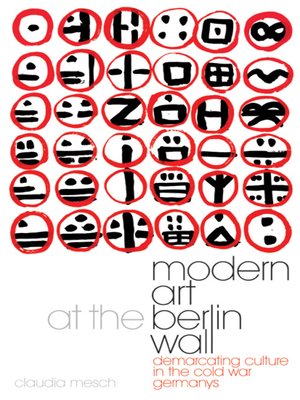
Sign up to save your library
With an OverDrive account, you can save your favorite libraries for at-a-glance information about availability. Find out more about OverDrive accounts.
Find this title in Libby, the library reading app by OverDrive.



Search for a digital library with this title
Title found at these libraries:
| Library Name | Distance |
|---|---|
| Loading... |
The proximity and shared history of East and West Germany has made Berlin an endlessly fascinating site of the Cold War. Here Claudia Mesch uncovers the dynamic history of art produced in divided Germany, and presents a new picture of the Cold War border between East and West as a dynamic and international cultural space. At the end of World War II, both Germanies faced the common problem of recovering and redefining modern art - museum buildings lay in ruins and Nazi confiscations and plunder had decimated every major public collection of modern art. A wide group of artists, American, Jewish and German, struggled to take visual art beyond the crude separations of the 'Iron Curtain', and to transcend the first global cultural divide of the twentieth century. The group included Joseph Beuys, Allan Kaprow, Gerhard Richter, Carolee Schneemann, Ed Kienholz, Yvonne Rainer, Jörg Immendorff and Nam June Paik. Their artwork engaged critically with imposed national and global identities, and with issues of memory and trauma that is far less known than official memorials and 'counter-memorials' to World War II. Mesch analyzes artworks across a number of different mediums including performance, painting and film, and also how some of these artworks were disseminated on television. Artists refashioned West Berlin as a center for avant-garde art that was constantly renewed by a stream of Eastern defectors and Western visitors. They forcefully contested the absolute demarcation of socialist and capitalist ideology forwarded by each state's art institutions, yet both seemed struck by amnesia about the vast trauma of World War II and the Holocaust. Mesch tracks major East and West German debates around modernism, and uncovers for the first time the existence of a critical socialist modernism in the former Soviet Bloc, practiced in East Germany by artists such as Manfred Butzmann, Wolfgang Mattheuer, A.R. Penck, and the artists' group Clara Mosch. An epilogue considers the recurring issues of cultural division and memory as they have been addressed in major artworks created in the united Berlin during the 1990s, including Peter Eisenman's 'Memorial to the Murdered Jews of Europe'. ''Around the Berlin Wall' presents a new chapter in the history of modern art in considering the cultural struggles of artists as they coped with the wide-scale trauma of World War II and the global ideological divide of the Cold War era. It challenges the perception that an absolute cultural separation existed between the capitalist West and the communist Soviet Bloc. With penetrating insights into the cultural coordination of new national identities and modernism's many legacies, this book is indispensable for all those interested in art history, modernism, the Cold War and the cultural history of the twentieth century.







